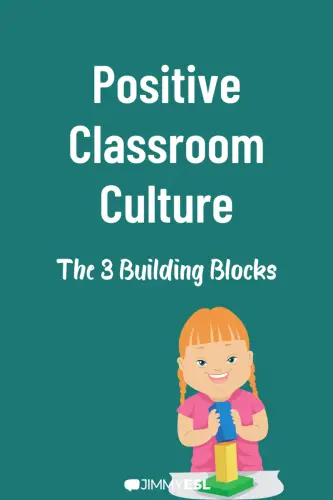The 3 Building Blocks of Positive Classroom Culture
Have you seen classes where everyone was running around and the teacher had no control over the students — or where the classroom was completely silent and the students were staring into space, either totally bored or too nervous to talk?
These classes contrast sharply with ones where everyone’s smiling and laughing and the classroom is full of energy and excitement.
Do teachers need secret superpowers to create interested, involved classes
Nope! All it takes to have a good class is a solid plan and some good old ‘sticktoitiveness’.
Creating a good classroom culture is imperative to fostering a class that’s bubbling, interested, and respectful.
Read on to find out what it takes to cultivate a curious and involved class and find out the three building blocks of positive classroom culture!
What Does Good Classroom Culture Look Like?
The thing about good classroom culture is that it’s not only good for your students — it also benefits you!
In a class with good classroom etiquette and culture, students are respectful, self-directed, and well-behaved.
They behave kindly and courteously to one another, they follow systems and routines in the classroom, and they feel empowered to learn and discover on their own.
When you foster positive classroom culture, you generate a system that allows students to feel safe, heard, and respected, and thus able to discover and grow without fear.
Creating a comprehensive classroom management plan will help you and your students to develop and maintain a positive culture.
The Three Building Blocks of Good Classroom Culture

Set Up Clear Classroom Expectations and Rewards Systems
The first step to creating a good classroom culture is to set up clear classroom expectations and to enforce your expectations with consistent, frequent rewards, as well as sparing and consistent punishments.
Developing classroom expectations and a system of enforcing together with your students is essential to establishing behavior norms and to helping them understand what kind of student they should aspire to be in your class.
Read this guide to classroom expectations for more information on classroom expectations and how they help establish classroom etiquette and culture!
Create Classroom Systems and Routines
Good classroom culture is a byproduct of systems and routines that give students a sense of security and control. You can nurture your students’ control over the classroom by initiating clear routines in your classroom.
When students have a system or routine that they follow, they don’t need to wait for you to tell them every single thing they need to do:
They can move onto the next task when they’re ready, and feel like they’re not just bodies in chairs but rather free agents who can direct their own learning experience and make decisions on their own.
Having routines might seem boring, but in fact, it gives students the freedom to create their own unique experiences within routine — and it takes some of the teaching work off of you!
What Does a Solid Classroom Routine Look Like?
What your class routine looks like will vary based on the size and level of your class and the age of your students.
In general, though, you should have routines for the start and end of class, and routines that go with different units.
Perhaps students take the first 5 minutes of class to turn in homework, prepare their things at their desks, and watch a funny video or have a group discussion over a topic at hand.
After that, you might introduce the lesson using a PPT before breaking students into groups to do work on their own, receiving and replacing any materials they might need from designated spots independently.
End class by having students clean up, ask any remaining questions, tally up rewards and demerits, and note down homework.
You can have a number of routines that you use during the middle of your class based on what unit you’re on or what kind of activity you’re doing, as long as students have rubrics and solid expectations they can draw from so they’re self-motivated and know what’s going on.
If you teach younger students, it’s a great idea to have activity stations where students can learn through playing in small groups.
Find out more about creating classroom routines for young learners by clicking on the link to the guide to classroom procedures!
Make Space For Student Input and Leadership
A classroom with good classroom culture is one where students are taking ownership of their learning experience, leading and asking questions on their own.
Foster these traits by creating room for lots of questions, presentations, projects, and discussions.
You can place a box for feedback in the back of your classroom to give shy students an outlet to make their voices heard.
You can even have an explicit conversation with students at the beginning of the semester where you emphasize that there are no wrong answers, that your classroom is a safe place for questioning and thinking, and that students may not mock or laugh at one another in your class.
Classroom Culture Starts With You! Model Good Classroom Etiquette and Behavior
As a teacher, you have enormous power to influence your students — for better or for worse. By being a good role model, you set an example for the kind of behavior you seek in your students.
Being a good role model means not being overly harsh or unfair (hey, if students can’t be mean to one another, then you can’t be mean to them!).
This doesn’t mean that you should be a pushover or totally buddy-buddy with your students, though.
You, the teacher, have the opportunity to show students how to stick up for what’s right and fair in a way that’s calm and even-keeled by modeling good behaviors. You can even note down these points on a blackboard together with other important rules.
You can also show how to ask big questions and find the answers to them, how to admit when you don’t know something, how to be a good listener.
Simply acting in a way that’s calm, respectful, and open to active discovery will give your students the tools to do the same. Don’t underestimate your power!
If you set up the three good building blocks for good classroom culture and act the way you want to see your students acting, you’re sure to find yourself with a class full of students that are kind, honest, interested, and more than ready to learn!
If you have students with different cultural backgrounds, our guide on culturally responsive teaching might help you, too.






